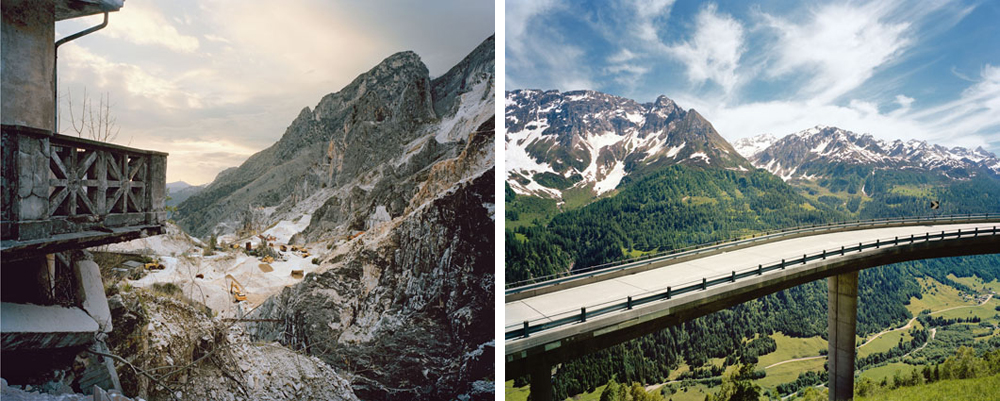Jörn Vanhöfen
Aftermath
March 15 — May 5, 2012
PRESS RELEASE IMAGES
In his debut exhibition at Robert Mann Gallery, Jörn Vanhöfen presents large format color photographs from his recent body of work, Aftermath. Although his subject is perhaps best characterized as human interventions in the landscape and the structures of civilization, Vanhöfen's images evince a psychological range extending beyond more familiar conceptions of post-New Topographics landscape photography. Not mere documents, these grand tableaus function as visual metaphors: allegories of architecture and the complex dynamic between nature and culture. Searching pictures, they suggest that amidst the decay and abandonment that all is not disconsolate and beyond redemption. Indeed, wit and awe appear in equal measure with outrage and condemnation. In one image from the series, a disconsolate apartment building, initially appearing passed over by the intractable advances of modernity, seems uninhabitable, until one notices the plume of smoke rising from the chimney — the sign of presence and beacon of persistence.
From sublime vertiginous vistas to restrained views on structures of refuse and ruin, Vanhöfen charts the effects of social drives that have globally propelled development and the pursuit of wealth. A peripatetic artist, Vanhöfen travels the world over, arriving at pictures that convey the tumult of the 21st century. Whether the harried trading floor of a Chicago commodities exchange or the humble structures of another era sequestered in the lee of freeway overpasses, Aftermath is sensitively attuned to the complex network of market and social forces. Mining the aesthetic and philosophical legacies of Romanticism, the artist deftly plays on established conventions while updating them to the concerns of the global present.
Formally complex, the photographs are remarkable for the restraint as much as the drama in the treatment of their subjects, a characteristic that carries over to the artist's delicate appreciation for the subtleties of chemical (as opposed to digital) printing. Stunning in their visual appeal and the artfulness of the photographer's craft, the images that comprise Aftermath depict a world unsettled, but not decimated.
Hatje Cantz published a catalogue of works in the series Aftermath in 2011.
Jörn Vanhöfen was born in Dinslaken, Germany in 1961. After initial studies in photography at the Folkwangschule Essen, he received his master's degree at the Hochscule für Grafik und Buchkunst in Leipzig. He has participated in exhibitions all over the world, including in Berlin, London, Tokyo, Amsterdam, Mexico City, and Havana. In addition to his own photographic output, Vanhöfen is an accomplished curator, critic, and educator. Vanhöfen lives in Berlin and Cape Town.
ARTNews
September 2012
Rebecca Robertson
The nine dramatic and unsettling photographs here portrayed large crumbling spaces that could be considered ironic landscapes. Mountains, beaches, a prison — all scarred by decay and the speed of modern life. A stone balcony frames what at first looks like a romantic mountain view, but, on closer view, reveals heavy machinery removing Carrara marble from the mountain. Elsewhere, a graveyard of burned trucks and tires glows in a misty pink light; in South Africa, dead tree trunks dot a sandy beach and stretch into the water, suggesting a long-ago disaster. Part of a larger series, these images all seemed to stand in for vaster, unnamed tragedies.
Several photos featured the curving arcs of cement expressways shooting through the frame. Zurich #367 (2011) shows a pink house tucked neatly beneath an overpass, a wisp of smoke coming from the chimney as in a scene from a fairy tale. Another building is hunched under a freeway in Duisburg #111 (2009). In Gotthard #2754 (2010), a loop of road seems to float above the green valleys and foothills of the distant Alps. At odds with their surroundings, these roads suggest contrasting ways of life.
The scale and subject of Vanhöfen's works readily call to mind Andreas Gursky's images of industry and commerce, but the comparison between the German photographers only goes so far. Gursky digitally removes what he deems unessential. By contrast, Vanhöfen includes it all. His photo of the Chicago Stock Exchange shows a whole universe — there are traders in a tight mass of action near the center of the photo, while below them, others nap at their desks amid a sea of papers and the occasional Cubs banner. Prices for lean hogs and live cattle scroll above them. Vanhöfen lets the messy world speak for itself.
The New Yorker
April 30, 2012
The big color prints in the German photographer's American début include landscapes and interior views that look a lot like Andreas Gursky's, but at a far less inflated scale. Both artists are fond of the broad, sweeping vista, but they undercut grandeur with ruin, overdevelopment, or everyday reality, particularly in Vanhöfen's picture of an empty elevated highway slicing through a postcard-perfect green valley. Vanhöfen is equally good with cramped spaces, notably in his images of old brick structures huddled under expressway overpasses. His best picture, though, is a theatrically hellish scene of destruction: the aftermath of a fire and the subsequent frost in an automobile junk yard. Through May 5.
Photo District News
April 23, 2012
Photo of the Day Blog
In his latest exhibit "Aftermath," German fine-art photographer Jörn Vanhöfen explores the physical, cultural and social forces at work around the world, and how they often collide with the natural world. The large-format color photos, now on display at the Robert Mann Gallery in New York City through May 5, are stunning in scale and detail. But they also evoke beauty, wit, drama and outrage in equal parts.
